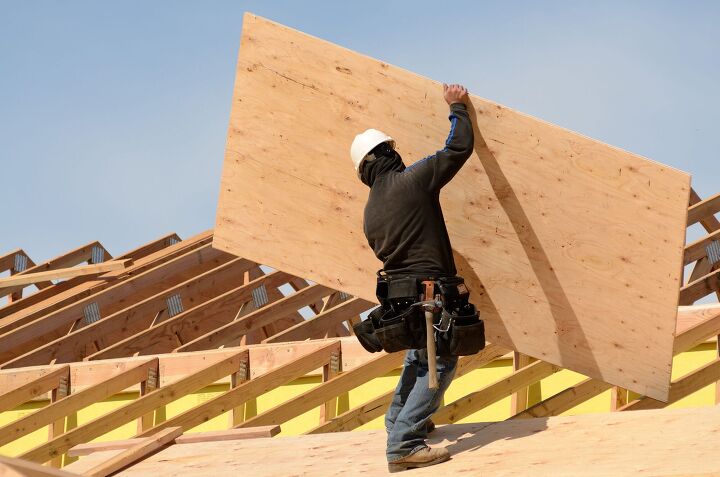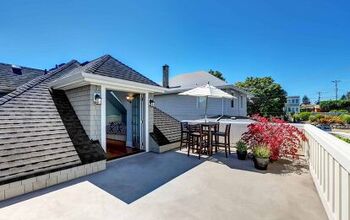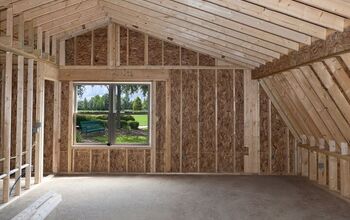How Much Does It Cost to Replace Plywood on A Roof?

If you are considering replacing your roof, get a quote from local contractors in your area here.
Roof decking, or sheathing, is the thin sheets of plywood (or some other material) that support your roof. If your roof decking is exposed to moisture, it can result in rot which impacts the structural integrity of your roof. This problem often goes unnoticed, as damage to roof decking is hidden above your attic insulation and underneath your roofing shingles.
There’s nothing worse than finding out that your roof needs structural repairs done. The concern about roofs is that issues aren’t always apparent unless a roofer or inspector gets up on your roof – and possibly even tears off the shingles. So, with that said, how much does it cost to replace the plywood on your roof?
Costs will vary based on the type of plywood used, the size of your home, and local labor costs in your area. A sheet of roofing plywood measures four feet by eight feet and covers approximately 32 square feet of roof area. With this in mind, it takes about 75 sheets to replace roof decking, or plywood sheathing on an average 2,400 square foot home – costing between $1,050 and $1,575 for just the material. Therefore, the average cost of sheathing is between $14 and $21 per sheet. Roofing labor, on the other hand, averages between $1.50 and $3.00 per square foot.
Like most home improvement projects, roof repairs and replacements always go the best when you prepare for the worst and expect the best – particularly in terms of budget. So, whether you need to replace the plywood on your roof now or suspect you will need to in the future, we’re here to help shed some light on the costs involved.
What is Roof Decking?
Also referred to as sheathing, roof decking is the foundation of your entire roofing system, connecting the roof to your home. It is the roofing material that sits between the structural components (joists and trusses) and the weatherproofing and insulation layers of the roof. Since the decking is the section of the roof that everything else is placed, it must be strong enough to hold the weight of the shingles and durable enough to allow for some give.
Although it’s not visible from the outside, your roof decking is very important to the structural integrity of your home. If the decking starts to rot and becomes unable to support the weight of your roof, this can result in serious structural concerns.
Types of Roof Decking
For residential structures, most roof decking is made from plywood or a plywood composite called Oriented Strand Board, or OSB. OSB consists of intertwining wood strands that are bonded together with a waterproof resin. It is a popular choice as roof decking due to its low price point. Plywood, on the other hand, may be slightly more expensive than OSB but it is denser and offers greater protection against moisture.
However, these aren’t the only types of roof sheathing used in the industry. There are many types of materials that can be used for roof decking, some of which are suitable for particular types of residential roofing systems:
- Oriented Strand Board (OSB): OSB is quickly becoming the most preferred material for roof sheathing. It is durable, widely available, and comes at a lower cost than many other alternatives. Oriented Strand Board is a synthetic material that is made out of fragments of wood, fused together with a specialized adhesive. The integration of the wood sheathing, along with modern engineer and technology, creates a sheathing material that is uniform, sturdy, and strong.
- Plywood: Another popular choice, half-inch construction-grade plywood has the same installation method as OSB. Both are installed with the standard spacing needed for thermal expansion and contraction. Because of plywood’s high density, moisture has a harder time infiltrating the wood and causing damage or rotting your roof. Like OSB, plywood is strong and durable, but is less susceptible to moisture accumulation and rot than OSB.
- Plank Sheathing: While not as popular as it was prior to the 1970s, plank sheathing is still in use for particular types of roofs, such as wood shakes. Instead of a flat-level plane, wood planks are spaced roughly one and half inches apart during installation to encourage airflow.
- Tongue and groove: Tongue and groove roof decking is constructed out of two by six boards. Each board features a “tongue” at one end and a “groove” on the other that locks into each other during the installation. This type of roof decking is commonly used on roofs that lack a ceiling. The boards offer a unique, aesthetic appeal when viewed from the inside.
- Concrete Sheathing: Concrete sheathing is used for situations that require high levels of strength and support for the roof. Concrete is gaining popularity for use in green and eco-friendly structures, and also serves as an excellent fireproofing material. This sheathing is usually poured into several forms or may be set on a roof in a pre-cast board. It is then reinforced with bars. Concrete sheathing is low maintenance, easy to clean, and reduces the risk of your roof sustaining any wind damage.
What Causes Roof Decking to Rot?
Unfortunately, the trouble with roofs is that issues aren’t usually obvious from the ground. In most cases, your roofer must get up on your roof and tear off your shingles to fully diagnose the problem. The number-one issue uncovered by roofers during a tear-off is plywood sheathing that is rotted or soft.
Water is your roof’s main enemy and since roof decking is made out of plywood or plywood composites, it is especially susceptible to water damage and rot when it’s exposed to excess moisture for a prolonged period of time. Whether its old and worn roofing shingles, torn flashing around your chimney, overflowing gutters, inadequate roof ventilation, ice dams or snow accumulation during winter months, or excess humidity and rising heat in your attic, there are a number of ways that moisture can slowly make its way into your roofing system and cause rotted roof decking.
Signs of Rotted Roof Decking
Some of the signs that could indicate that your roof’s plywood sheathing is rotted include:
- Wet spots on your ceiling.
- Water stains on your rafters.
- Roof leaks.
- Stains on interior walls.
- Sagging ceiling or roofline.
- Peeling wallpaper and cracked paint.
- Mold and mildew growth in your attic.
Roof leaks are one of the most common signs that roof decking is damaged. Water leaks can result in peeling wallpaper, cracked paint, stains on interior walls, and leaks or spots on your ceiling. An inspection in your attic may reveal dark water stains in the insulation or on the rafters. You may even find light escaping through holes in the roof. If left unaddressed, mold and mildew will start to form in the walls, insulation, ceiling.
A roofline or ceiling that sags is another indication that there are major issues with the roof’s decking and the structure of the roof as a whole. Decking that is soaked or waterlogged can warp, which can cause a bowed or wavy ceiling and roofline.
Should Roof Decking be Repaired or Replaced?
If you’re wondering if you can fix the issues with your roof decking by performing a quick patch job, think again. When it comes to rot, repairing your roof decking is simply not an option – it must be completely replaced. In fact, the longer you wait without replacing your damaged roof decking, the more problems that can arise, leading to more mold and mildew growth and expensive repairs.
Cost to Install Plywood Sheathing or Replace Roof Decking
Your roofer will typically only charge you for the materials and labor required to complete the project. With that in mind, plywood roofing sheathing measure four feet by eight feet and may be anywhere from ¼ of an inch thick to 5/8 of an inch thick. The thicker the plywood used, the more expensive it will be to replace. Costs can also vary based on how much the roofing company charges for labor.
A 4 by 8 sheet of plywood covers approximately 32 square feet of roof area. With that said, the average cost to replace roof decking on a 2,400 square foot home is between $1,050 and $1,575. It’ll take roughly 75 sheets of plywood to complete the job, putting the average cost of sheathing at $14 to $21 per sheet.
Repairing the plywood sheathing on a smaller, 1,100 square foot home will only require 34 sheets for an average cost of $600. The table below outlines the average cost ranges and amount of sheathing required to repair roof decking on various home sizes:
| Home Size | Plywood Sheathing Required | Average Cost Range |
| 1,100 square feet | 34 sheets | $481 to $722 |
| 2,400 square feet | 75 sheets | $1,050 to $1,575 |
| 3,400 square feet | 106 sheets | $1,488 to $2,231 |
Roofing Labor Costs
Now that you understand the cost of materials required to replace the plywood on a roof, you must also consider labor costs. With a couple of variables at play, roofing labor averages between $1.00 and $3.00 per square foot. However, some roofing professionals charge per square (10×10 area), meaning their labor costs will reflect this multiplied by 100 – costing between $150 and $300 per square.
How Often Should Your Roof Be Inspected?
As your roof is constantly exposed to a variety of weather conditions, the National Roofing Contractors Association urges that your roof be inspected by a professional twice per year – once in the fall, after the hot weather has dwindled down, and again in the spring, after the danger of snow and ice has subsided. It’s also highly recommended that your roof be inspected after a massive storm, hurricane, or any other possibly damaging weather occurrence.
Cost of Roof Inspection
Having a roof inspection done helps to identify potential issues, provides solutions on what needs fixing, determines the condition and lifespan of your roof, and can help you keep your roof in good condition. As previously mentioned, it’s recommended that you have an inspection done twice a year, or after a major storm, to help you get ahead of problems before they become large or expensive.
Not to mention, a roof inspection will help determine whether your roof sheathing is damaged, rotted, and needs to be replaced. The average cost for a roof inspection is between $100 and $600, with most homeowners paying around $350 for both an internal and external inspection on a 1,500 square foot sloped roof. The actual price that you pay for a roof inspection varies based on the size, material, pitch, and condition of your roof.
Related Guide
UpgradedHome participates in affiliate programs. When you purchase through our links, we may earn a commission.

Jessica considers herself a home improvement and design enthusiast. She grew up surrounded by constant home improvement projects and owes most of what she knows to helping her dad renovate her childhood home. Being a Los Angeles resident, Jessica spends a lot of her time looking for her next DIY project and sharing her love for home design.
More by Jessica Stone













![How Much Does Roof Inspection Cost? [2022 Rates]](https://cdn-fastly.upgradedhome.com/media/2023/07/31/9092683/how-much-does-roof-inspection-cost-2022-rates.jpg?size=350x220)













